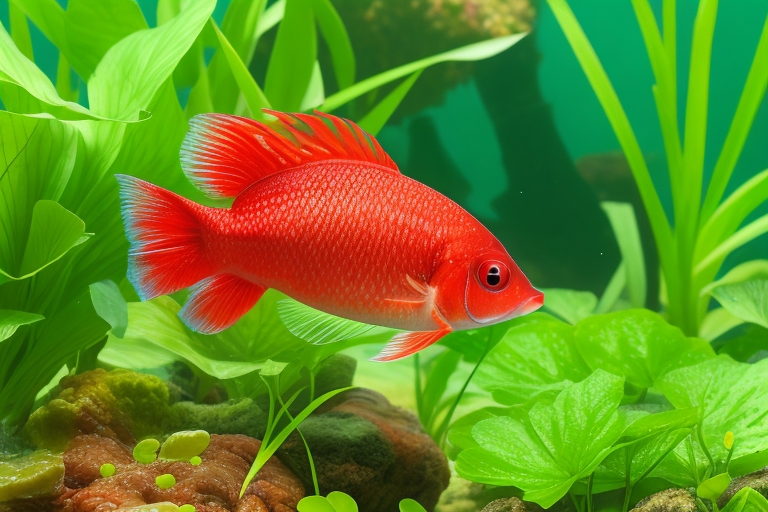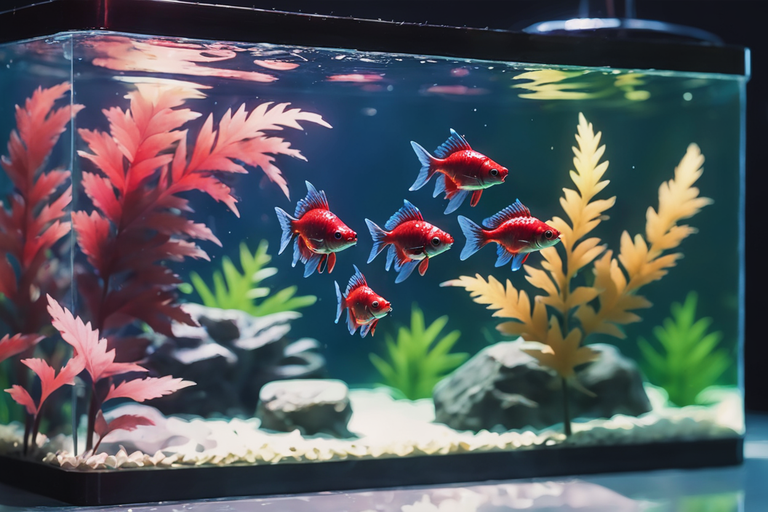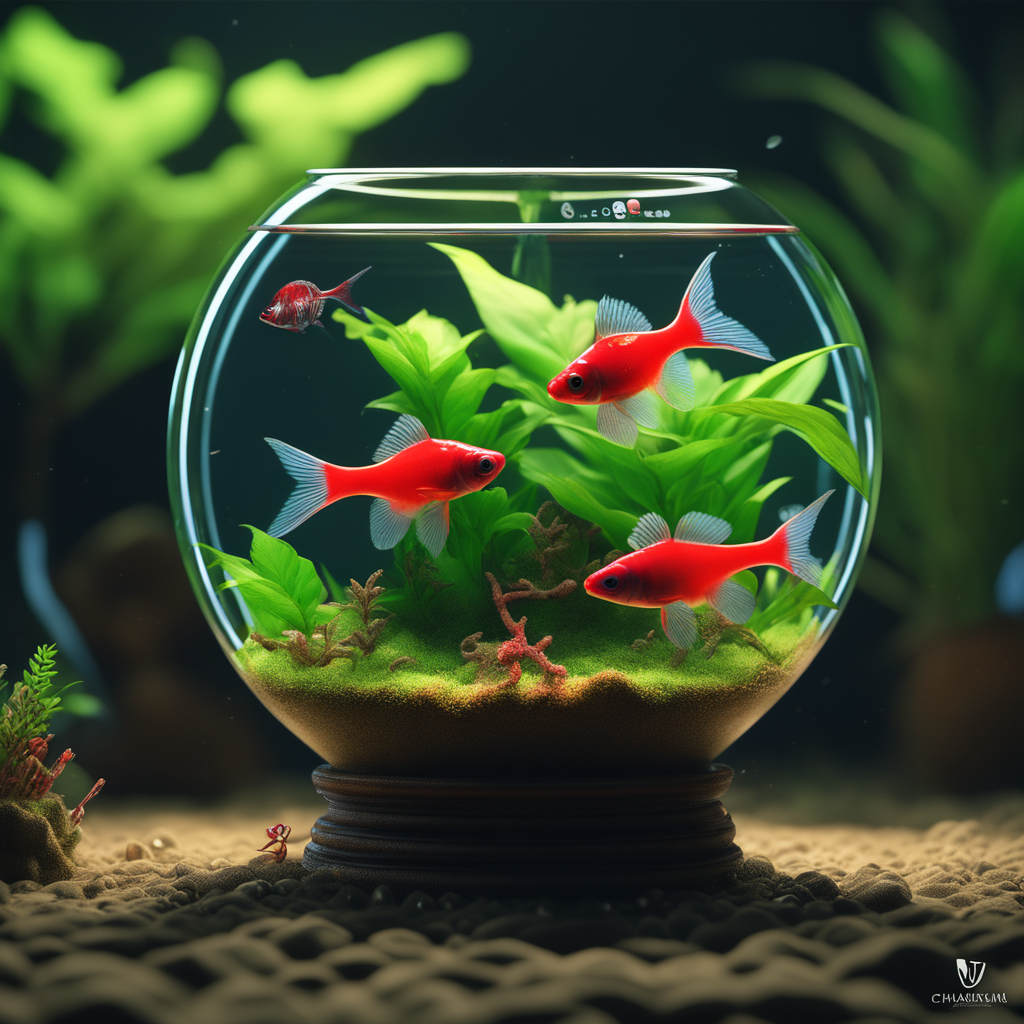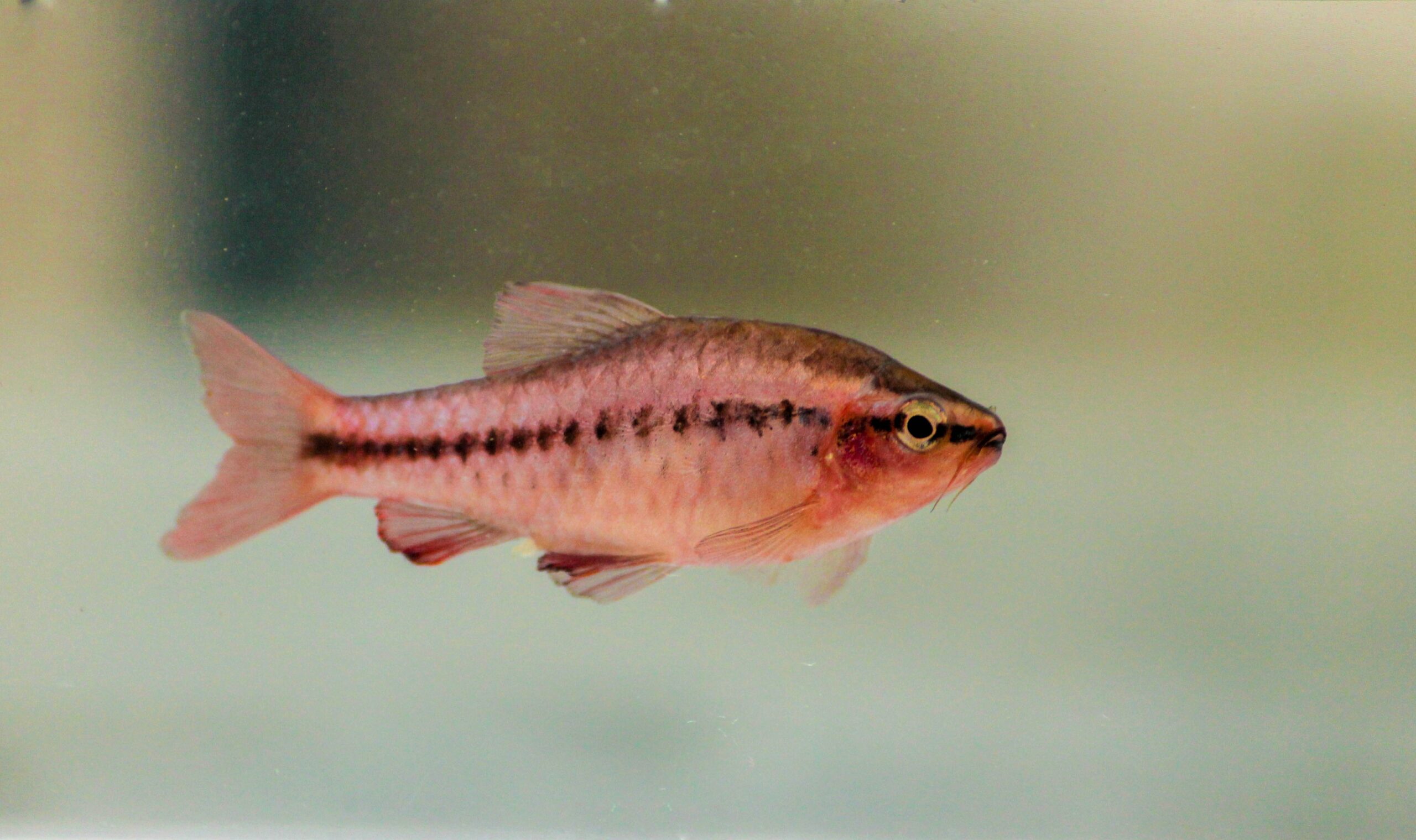This friendly and hardy species is native to Sri Lanka and is relatively easy to care for, making it a great choice for beginners.
Are you looking for a unique and colorful fish to add to your aquarium? Look no further than the Cherry Barb!
Read on to find out everything you need to know about the Cherry Barb and how to give it the best possible care.
What you will learn from this article
- Cherry Barb (Puntius titteya) is a small, peaceful freshwater fish species native to Sri Lanka.
- They are known for their vibrant coloration, with males displaying bright red or cherry-colored bodies.
- The females have less intense colors and may appear more yellowish in comparison.
- These barbs have an elongated body shape that can reach up to 5 centimeters in length when fully grown.
- Cherry Barbs prefer well-planted aquariums with ample swimming space and hiding spots created by plants or decorations like driftwood.
- In terms of water conditions, they thrive best in slightly acidic to slightly alkaline waters with temperatures ranging from 72-79 °F (22-26°C).
- This species is omnivorous and will eat various types of food such as flakes, pellets, freeze-dried or live foods including brine shrimp and daphnia.
- Breeding Cherry Barbs is relatively easy as they are egg scatterers that lay their eggs near plant roots or underneath floating vegetation.
- Female barbs can produce hundreds of eggs during each breeding cycle but it’s recommended to provide them with separate breeding tanks for optimal success rates
- The average lifespan of the Cherry Barb is around 3-5 years when cared for properly.
Cherry Barb Facts & Overview

You can quickly learn about the Cherry Barbs’ vibrant coloration, size, and behavior by reading up on their facts and overview.
Originating from Sri Lanka, these fish can grow up to 2 inches in length. Males have bright red coloration, while females are tan and appear fatter. They’ve a dark line along their body with small, translucent fins and a half-shell-shaped dorsal fin.
When it comes to habitat requirements, they’re suited for tropical rainforest conditions and require slow-moving water sources. Their lifespan ranges from 3 to 5 years and tank setup should include filtration through a hang-on back filter. Water parameters should include a temperature range of 73°F to 81°F, pH of 7.2 to 7.5, and hardness of 5 dH to 19 dH.
They’re omnivores with feeding habits of pellet food, frozen foods, and live foods. To prevent disease, regular cleaning and testing of water conditions are important.
Breeding behavior includes preparation of a breeding tank and care for the fry. They’re social fish and should be kept in groups of at least 5. With their ease of care and compatibility with community tanks, Cherry Barbs are a great addition to any aquarium.
Appearance & Behavior

You’ll love the vibrant coloration of Cherry Barbs and their peaceful behavior. Males are bright red while females are tan in color, with both having a dark line along their body and small translucent fins. Males are more colorful than females and appear thinner.
In terms of social behavior, Cherry Barbs are schooling fish and should be kept in groups of at least 5. They’re active swimmers and respond well to tank mates. They also interact well with other species and can be seen exploring tank decorations.
In terms of feeding, they’re omnivores and enjoy a variety of meaty and vegetable-based foods.
As for reproductive behaviors, they can reproduce in the aquarium if the water conditions are ideal.
Cherry Barb Care & Tank Requirements
Caring for Cherry Barbs is relatively easy, as they require specific water parameters and a hang-on back filter for filtration. The ideal temperature ranges from 73°F to 81°F, the pH level should be between 7.2 and 7.5, and the water hardness should range from 5 dH to 19 dH. Regular tank cleaning and water testing are also essential.
Symptoms of ill health include changes in behavior, loss of appetite, and physical signs of illness. Common health issues that may affect Cherry Barbs are Ich, velvet disease, fin rot, and dropsy, which can be treated with medications.
Breeding Cherry Barbs requires preparation of a breeding tank and care for the fry. It’s important to keep in mind that these fish require a filtered aquarium and shouldn’t be kept in room temperatures; a heater may be necessary in colder climates.
With the right care and maintenance, Cherry Barbs will thrive in their environment and bring plenty of vibrant color to any aquarium.
Tank Mates

When choosing tank mates for Cherry Barbs, it’s important to select species that are compatible with them. There are several ideal tank mates for Cherry Barbs, including compatible fish species such as tetras, guppies, and other peaceful fish. When choosing tank mates, it’s important to avoid aggressive species and choose ones that won’t disturb the Cherry Barbs. Community tank options are also a good choice, as they provide a wide variety of fish for the Cherry Barbs to interact with.
Schooling fish companions such as White Cloud Mountain Minnows and Celestial Pearl Danios are great choices for Cherry Barbs, as they’ll provide the Barbs with a sense of security and safety. Bottom-dwelling tank mates such as Corydoras Catfish or Otocinclus Catfish are also great choices, as they tend to be peaceful and less likely to hassle the Cherry Barbs.
When it comes to mixing with other barb species, it’s important to keep the genders separate as they can be prone to aggression if kept together. Avoid breeding two different barb species together as this can create hybrid offspring. It’s also important to make sure that the tank is large enough to accommodate all the tank mates without overcrowding.
To ensure a peaceful and harmonious tank, it’s important to choose tank mates that are peaceful and non-aggressive. This will ensure that the Cherry Barbs aren’t stressed or harassed by their tank mates, creating a happy and healthy environment for them to thrive in.
4 Item Numeric List in Markdown Format:
- Ideal tank mates
- Compatible fish species
- Choosing tank mates
- Community tank options
Diet and Feeding

You’ll need to provide your Cherry Barbs with a varied diet, and they should be fed multiple times a day. The best feeding schedule is 2 to 3 times a day with only as much food as they can consume within a few minutes.
In terms of types of food, you can feed them a variety of live, frozen, and freeze-dried foods such as bloodworms, brine shrimp, daphnia, and other small invertebrates. It’s important to note that they’ve different nutritional requirements, so a balanced diet is key.
When it comes to feeding habits, it’s important to pay attention to their feeding behavior and adjust accordingly. Make sure to provide a variety of food types and sizes, as well as plenty of hiding spots. Feeding tips include using a variety of methods such as tweezers, feeding tongs, or even a pipette.
When it comes to preferred food choices, Cherry Barbs tend to enjoy small insects, worms, and larvae. As far as feeding frequency, it’s best to feed them small amounts frequently instead of large amounts infrequently.
When it comes to feeding challenges, make sure to remove any uneaten food from the tank to prevent ammonia and nitrate spikes. With proper nutrition and feeding techniques, your Cherry Barbs will thrive and be a welcome addition to any freshwater aquarium.
Breeding

You can easily breed your Cherry Barbs at home, and they’ll reproduce quickly if conditions are right. Breeding these fish requires a few steps and techniques, including setting up a separate breeding tank, selecting breeding pairs, and providing the correct environmental triggers.
Here are some tips for successful breeding:
- Setting up a breeding tank: Make sure the tank is well-filtered and has a steady temperature of 73°F-81°F.
- Selecting breeding pairs: Find healthy, vibrant fish that are at least 1 inch in length.
- Fry care: Provide ample food sources and keep the tank clean.
- Breeding behavior: Cherry Barbs usually breed during the spring months and prefer slow-moving water.
- Breeding triggers: Increase water temperature and provide hiding places to encourage spawning.
- Breeding challenges: Be aware that Ich and velvet disease can affect breeding success.
- Breeding season: Breeding will occur during the warmer months.
- Breeding success tips: Test water parameters regularly and provide plenty of plants for cover.
- Breeding community tanks: Cherry Barbs can be bred in a community tank, but be sure to remove fry when they hatch.
- Breeding triggers: Spawning is usually triggered by a change in the environment, such as a change in temperature or an increase in food sources.
With the right conditions and techniques, you can breed Cherry Barbs at home. Good luck!
Frequently Asked Questions
What Is the Ideal Water Temperature for Cherry Barbs?
For optimal health, Cherry Barbs need a water temperature of 73°F to 81°F. You’ll also need to consider tank size, water parameters, diet requirements, hiding spots, color variations, tank decorations, water quality, tank setup, and aquarium lighting.
What Types of Illnesses Can Affect Cherry Barbs?
Common illnesses that can affect Cherry Barbs include Ich, velvet disease, fin rot, and dropsy. Temperature fluctuations, water chemistry, diet selection, substrate choice, tank size, compatible species, water change frequency, and filter selection can also contribute to skin diseases and bacterial infections.
What Types of Fish Make Good Tank Mates for Cherry Barbs?
Peaceful species like tetras, rasboras, and danios make great tank mates for Cherry Barbs. Consider tank size, diet, decor, breeding, lifespan, cycle, water quality, and stress levels when selecting compatible fish.
How Often Should the Tank Be Cleaned for Cherry Barbs?
Clean your tank often to ensure healthy water quality and prevent diseases in Cherry Barbs. Aim for at least weekly, depending on tank size, lighting, plant choice, and decorations. Regularly check for signs of stress and adjust feeding habits accordingly. Breeding tips, such as proper tank setup, can also help.
What Type of Filter Should Be Used for Cherry Barbs?
Installing a hang-on back filter is the best option for your cherry barb tank. Consider the tank size, water parameters, diet needs, tank decoration, compatibility concerns, tank cycling, water testing, and diseases prevention when selecting a filter type.
Conclusion
All in all, the Cherry Barb is an excellent fish to add to your aquarium.
It’s peaceful, hardy, and adaptable, and with the right care and tank requirements, it can thrive in any tank.
Keep in mind that it’s best kept in a community tank with appropriate tank mates, and be sure to provide a varied diet to ensure its health and wellbeing.
With a bit of knowledge and dedication, you’ll soon have a beautiful and vibrant aquarium full of happy Cherry Barbs!

